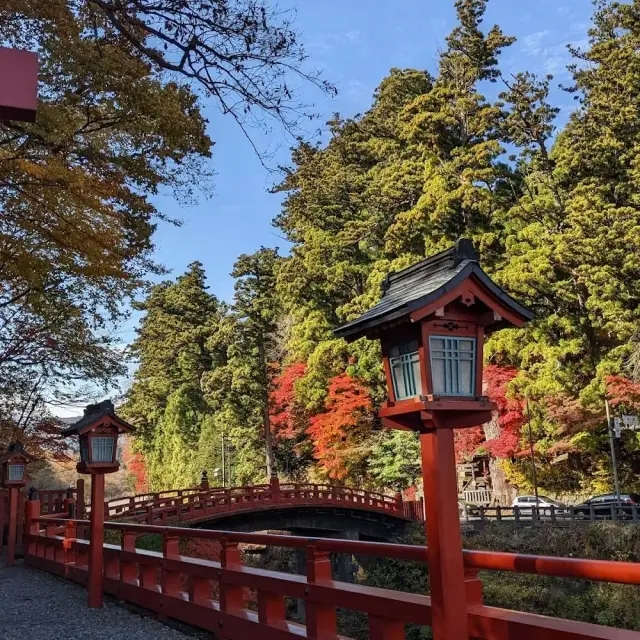https://www.dekitabi.com/itinerary/nikko-temple-essential-tour
Nikko, a UNESCO World Heritage site nestled in Tochigi Prefecture, offers an enchanting glimpse into Japan’s rich cultural and spiritual heritage. From the iconic Shinkyo Bridge to the revered Nikkozan Rinnoji Temple and the historical treasures of the Nikko Toshogu Museum, each landmark in Nikko tells a unique story. This guide delves into the must-visit sites in Nikko, showcasing their historical significance and spiritual allure.
Shinkyo Bridge: The Sacred Gateway to Nikko

https://www.dekitabi.com/attraction/shinkyo-bridge
Shinkyo Bridge, a striking red-lacquered wooden bridge, is an emblem of Nikko’s spiritual significance. Spanning the Daiya River, Shinkyo Bridge has been an important site since the early 17th century. Historically, it served as the sacred gateway to the Nikko mountains and was the entrance for pilgrims on their way to the Toshogu Shrine.
The bridge’s vivid vermilion color contrasts beautifully with the lush green surroundings, making it a picturesque spot for visitors. Shinkyo Bridge is not only a symbol of Nikko’s cultural heritage but also an architectural marvel, reflecting the precision and artistry of Edo-period craftsmanship.
Nikkozan Rinnoji Temple: A Sanctuary of Tranquility

https://www.dekitabi.com/attraction/rinnoji-temple
Nikkozan Rinnoji Temple, founded in the 8th century by the Buddhist monk Shodo Shonin, is a cornerstone of Nikko’s spiritual landscape. As the head temple of the Rinnoji School of Shingon Buddhism, it serves as a major pilgrimage site. The temple complex features several structures, including the Sanbutsudo Hall, which houses three golden statues of the Amida, Senju Kannon, and Bato Kannon deities.
The temple’s serene grounds, traditional architecture, and vibrant gardens offer a peaceful retreat from the bustling city life. The Rinnoji Temple is renowned for its historical artifacts and beautiful seasonal flora, making it a captivating destination throughout the year.
Nikko Toshogu Museum: Unveiling Historical Treasures

https://www.dekitabi.com/attraction/nikko-toshogu-museum
The Nikko Toshogu Museum provides a comprehensive insight into the life and legacy of Tokugawa Ieyasu, the founder of the Tokugawa Shogunate. Located near the Toshogu Shrine, the museum showcases a wide array of artifacts, including ceremonial objects, historical documents, and personal items related to Ieyasu and his era.
The museum’s exhibits are meticulously curated to offer a deep understanding of the Tokugawa period and the cultural heritage of Nikko. Visitors can explore the historical context of the Toshogu Shrine and appreciate the craftsmanship of the artifacts on display.
Nikko Toshogu: The Mausoleum of a Shogun

https://www.dekitabi.com/attraction/nikko-toshogu-shrine
Nikko Toshogu Shrine, dedicated to Tokugawa Ieyasu, is one of Japan’s most elaborate and significant Shinto shrines. Built in 1617, it stands as a testament to the grandeur of the Tokugawa Shogunate. The shrine’s intricate carvings, ornate decorations, and majestic structures reflect the artistic brilliance of the early 17th century.
The main hall, Honden, is adorned with detailed woodwork and vibrant colors, while the Yomeimon Gate is renowned for its intricate carvings and elaborate design. The Toshogu Shrine complex also includes the Taiyuin Mausoleum, where Tokugawa Ieyasu’s grandson, Tokugawa Iemitsu, is enshrined. The shrine’s serene atmosphere and historical significance make it a focal point of Nikko’s spiritual heritage.
Nikko Futarasan Shrine: A Spiritual Harmony

https://www.dekitabi.com/attraction/nikko-futarasan-jinja
Nikko Futarasan Shrine, dedicated to the deities of the Nikko mountains, is a pivotal site in Nikko’s spiritual landscape. Founded in the 8th century, it is associated with the natural beauty and sacredness of the surrounding mountains. The shrine’s tranquil setting and historical structures make it a revered destination for worshippers and tourists alike.
The shrine complex includes the Main Shrine (Honden), which features traditional Shinto architecture and a sacred tree believed to be over 1,000 years old. The Futarasan Shrine is also known for its annual festivals and rituals that celebrate the harmony between nature and spirituality.
Rinnoji Taiyuin: The Mausoleum of Tokugawa Iemitsu

https://www.dekitabi.com/attraction/taiyuin-temple
The Rinnoji Taiyuin, or Taiyuin Mausoleum, is a majestic final resting place of Tokugawa Iemitsu, the third shogun of the Tokugawa Shogunate. Located within the Rinnoji Temple complex, the mausoleum is a grand example of Edo-period architecture and artistry.
The Taiyuin Mausoleum features intricately designed gates, serene gardens, and detailed carvings that reflect the era’s opulence and craftsmanship. The mausoleum’s peaceful ambiance and historical significance make it a meaningful addition to Nikko’s cultural heritage.
Experience Nikko’s Spiritual and Historical Richness
Nikko offers a profound exploration of Japan’s spiritual and historical heritage through its iconic sites. From the stunning Shinkyo Bridge to the grand Toshogu Shrine and the serene Rinnoji Temple, each destination provides a unique glimpse into Japan’s cultural tapestry. The Nikko Toshogu Museum and Rinnoji Taiyuin further enhance the experience with their historical insights and architectural splendor.
Visiting Nikko is more than a journey through a picturesque landscape; it is an immersion into the heart of Japan’s spiritual and historical legacy.


Leave a Reply